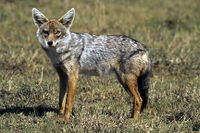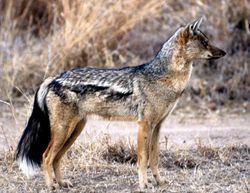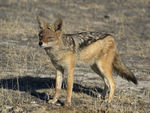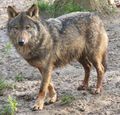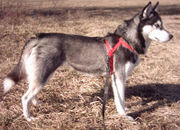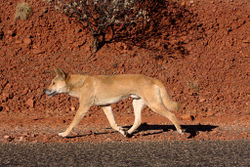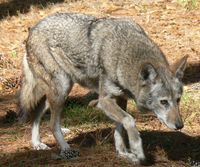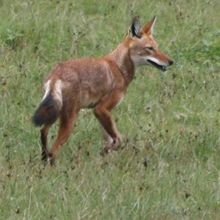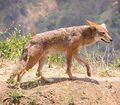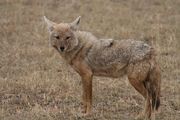Canis
Canis is a genus containing 7 to 10 extant species, including dogs, wolves, coyotes, and jackals, and many extinct species.
Wolves, dogs, and dingos
Wolves, dogs and dingos are subspecies of Canis lupus. The original referent of the English word wolf, the Eurasian Grey Wolf, is called Canis lupus lupus to distinguish it from other wolf subspecies, such as the Iranian Wolf (Canis lupus pallipes), the Arabian Wolf (Canis lupus arabs), or the Tibetan Wolf (Canis lupus chanco), which are probably more similar to the variety of wolf that was ancestral to the modern dog (Canis lupus familiaris).
Some experts have suggested that some subspecies of C. lupus be considered Canis species distinct from Canis lupus. These include Central Asia's Himalayan wolf, and the Indian Wolf, as well as the North American's Red wolf and Eastern Wolf.
The dingo (C. lupus dingo), from Australia, and the domestic dog (C. lupus familiaris) are also considered subspecies of Canis lupus, although they themselves are not commonly referred to or thought of as "wolves".[2]
Coyotes, Jackals, and "wolves"
C. lupus is but one of many Canis species, most of which are now extinct and little known to the general public. One of these, however, the Dire Wolf, has gained fame for the thousands of specimens found and displayed at the La Brea Tar Pits in Los Angeles, California.
The Dire Wolf is an example of the word "wolf" being applied loosely, i.e.: to a canid which is not Canis lupus. Other examples include Canis simensis, which has undergone many popular name changes, as its intermediate morphology had caused some to think of it as a jackal or a fox; but current taxonomic and genetic consensus is reflected in its "official name," the Ethiopian Wolf.
Canis species too small to attract the word "wolf" are called "coyotes" in the Americas and Jackals elsewhere. Although these may not be more closely related to each other than they are to C. lupus, they are, as fellow Canis species, all more closely related to wolves and domestic dogs than they are to foxes, Maned Wolves, or other canids which do not belong to the Canis genus. The word "jackal" is applied to three distinct species of this group: Africa's Side-striped (C. adustus) and Black-backed jackals (C. mesomelas); and the Golden Jackal (C. aureus), which can be found across northern Africa, southwestern and south central Asia, and the Balkans.
While North America has only one small-sized species, the Coyote (C. latrans), it has become very widespread indeed, moving into areas once occupied by wolves. They can be found across much of mainland Canada; in every state of the continental United States; all of Mexico except the Yucatan peninsula; and Pacific and central areas of Central America, ranging as far south as northern Panama.
Etymology
The name Canis means "dog" in Latin. The word canine comes from the adjective form, caninus ("of the dog"), from which the term canine tooth is also derived.[3] The canine family has prominent canine teeth, used for killing their prey.
Gallery
|
|
|
|
|
Eastern Wolf (Canis lupus lycaon)
|
|
|
|
Side-striped Jackal (Canis adustus)
|
|
Black-backed Jackal (Canis mesomelas)
|
References
See also
- Himalayan Wolf
- Indian Wolf
- List of Canis species
|
Extant Carnivora species |
|
| Kingdom: Animalia · Phylum: Chordata · Class: Mammalia · Infraclass: Eutheria · Superorder: Laurasiatheria |
|
|
Suborder Feliformia |
|
| Nandiniidae |
|
Nandinia
|
African Palm Civet (N. binotata)
|
|
|
Herpestidae
(Mongooses) |
|
Atilax
|
Marsh Mongoose (A. paludinosus)
|
|
|
Bdeogale
|
Bushy-tailed Mongoose (B. crassicauda) · Jackson's Mongoose (B. jacksoni) · Black-footed Mongoose (B. nigripes)
|
|
|
Crossarchus
|
Alexander's Kusimanse (C. alexandri) · Angolan Kusimanse (C. ansorgei) · Common Kusimanse (C. obscurus) · Flat-headed Kusimanse (C. platycephalus)
|
|
|
Cynictis
|
Yellow Mongoose (C. penicillata)
|
|
|
Dologale
|
Pousargues's Mongoose (D. dybowskii)
|
|
|
Galerella
|
Angolan Slender Mongoose (G. flavescens) · Somalian Slender Mongoose (G. ochracea) · Cape Gray Mongoose (G. pulverulenta) · Slender Mongoose (G. sanguinea)
|
|
|
Helogale
|
Ethiopian Dwarf Mongoose (H. hirtula) · Common Dwarf Mongoose (H. parvula)
|
|
|
Herpestes
|
Short-tailed Mongoose (H. brachyurus) · Indian Gray Mongoose (H. edwardsii) · Indian Brown Mongoose (H. fuscus) · Egyptian Mongoose (H. ichneumon) · Small Asian Mongoose (H. javanicus) · Long-nosed Mongoose (H. naso) · Collared Mongoose (H. semitorquatus) · Ruddy Mongoose (H. smithii) · Crab-eating Mongoose (H. urva) · Stripe-necked Mongoose (H. vitticollis)
|
|
|
Ichneumia
|
White-tailed Mongoose (I. albicauda)
|
|
|
Liberiictus
|
Liberian Mongoose (L. kuhni)
|
|
|
Mungos
|
Gambian Mongoose (M. gambianus) · Banded Mongoose (M. mungo)
|
|
|
Paracynictis
|
Selous' Mongoose (P. selousi)
|
|
|
Rhynchogale
|
Meller's Mongoose (R. melleri)
|
|
|
|
|
|
|
Hyaenidae
(Hyenas) |
|
|
| Felidae |
Large family listed below
|
|
| Viverridae |
Large family listed below
|
|
| Eupleridae |
Small family listed below
|
|
|
|
|
Family Felidae |
|
| Felinae |
|
Acinonyx
|
|
|
|
|
|
|
|
Catopuma
|
|
|
|
Felis
|
|
|
|
Leopardus
|
Pantanal Cat ( L. braccatus) · Colocolo ( L. colocolo) · Geoffroy's Cat ( L. geoffroyi) · Kodkod ( L. guigna) · Andean Mountain Cat ( L. jacobitus) · Pampas Cat ( L. pajeros) · Ocelot (L. pardalis) · Oncilla (L. tigrinus) · Margay ( L. wiedii) |
|
|
|
|
|
|
|
|
|
|
Pardofelis
|
Marbled Cat (P. marmorata)
|
|
|
Prionailurus
|
|
|
|
Profelis
|
African Golden Cat (P. aurata)
|
|
|
Puma
|
|
|
|
| Pantherinae |
|
|
|
|
|
Family Viverridae (includes Civets) |
|
| Paradoxurinae |
|
|
|
|
|
Arctogalidia
|
Small-toothed Palm Civet (A. trivirgata)
|
|
|
Macrogalidia
|
Sulawesi Palm Civet (M. musschenbroekii)
|
|
|
Paguma
|
Masked Palm Civet (P. larvata)
|
|
|
Paradoxurus
|
|
|
|
| Hemigalinae |
|
Chrotogale
|
Owston's Palm Civet (C. owstoni)
|
|
|
Cynogale
|
Otter Civet (C. bennettii)
|
|
|
Diplogale
|
Hose's Palm Civet (D. hosei)
|
|
|
Hemigalus
|
Banded Palm Civet (H. derbyanus)
|
|
|
Prionodontinae
(Asiatic linsangs) |
|
Prionodon
|
Banded Linsang (P. linsang) · Spotted Linsang (P. pardicolor)
|
|
|
| Viverrinae |
|
Civettictis
|
African Civet (C. civetta)
|
|
|
Genetta
(Genets)
|
Abyssinian Genet (G. abyssinica) · Angolan Genet (G. angolensis) · Bourlon's Genet (G. bourloni) · Crested Servaline Genet (G. cristata) · Common Genet (G. genetta) · Johnston's Genet (G. johnstoni) · Rusty-spotted Genet (G. maculata) · Pardine Genet (G. pardina) · Aquatic Genet (G. piscivora) · King Genet (G. poensis) · Servaline Genet (G. servalina) · Haussa Genet (G. thierryi) · Cape Genet (G. tigrina) · Giant Forest Genet (G. victoriae)
|
|
|
Poiana
|
Leighton's Linsang (P. leightoni) · African Linsang (P. richardsonii)
|
|
|
Viverra
|
Malabar Large-spotted Civet (V. civettina) · Large-spotted Civet (V. megaspila) · Malayan Civet (V. tangalunga) · Large Indian Civet (V. zibetha)
|
|
|
Viverricula
|
Small Indian Civet (V. indica)
|
|
|
|
|
|
Family Eupleridae |
|
| Euplerinae |
|
|
|
|
|
Eupleres
|
Falanouc (E. goudotii)
|
|
|
Fossa
|
Malagasy Civet (F. fossana)
|
|
|
| Galidiinae |
|
Galidia
|
Ring-tailed Mongoose (G. elegans)
|
|
|
Galidictis
|
Broad-striped Malagasy Mongoose (G. fasciata) · Grandidier's Mongoose (G. grandidieri)
|
|
|
Mungotictis
|
Narrow-striped Mongoose (M. decemlineata)
|
|
|
Salanoia
|
Brown-tailed Mongoose (S. concolor)
|
|
|
|
|
|
Suborder Caniformia (cont. below) |
|
Ursidae
(Bears) |
|
Ailuropoda
|
Giant Panda (A. melanoleuca)
|
|
|
|
|
|
|
|
|
|
|
|
|
|
|
Ursus
|
|
|
|
Mephitidae
(Skunks) |
|
Conepatus
(Hog-nosed
skunks)
|
Molina's Hog-nosed Skunk (C. chinga) · Humboldt's Hog-nosed Skunk (C. humboldtii) · American Hog-nosed Skunk (C. leuconotus) · Striped Hog-nosed Skunk (C. semistriatus)
|
|
|
Mephitis
|
Hooded Skunk (M. macroura) · Striped Skunk (M. mephitis)
|
|
|
Mydaus
|
Sunda Stink Badger (M. javanensis) · Palawan Stink Badger (M. marchei)
|
|
|
Spilogale
(Spotted skunks)
|
Southern Spotted Skunk (S. angustifrons) · Western Spotted Skunk (S. gracilis) · Eastern Spotted Skunk (S. putorius) · Pygmy Spotted Skunk (S. pygmaea)
|
|
|
| Procyonidae |
|
Bassaricyon
(Olingos)
|
Allen's Olingo (B. alleni) · Beddard's Olingo (B. beddardi) · Bushy-tailed Olingo (B. gabbii) · Harris's Olingo (B. lasius) · Chiriqui Olingo (B. pauli)
|
|
|
Bassariscus
|
Ring-tailed Cat (B. astutus) · Cacomistle (B. sumichrasti)
|
|
|
Nasua
(Coatis inclusive)
|
White-nosed Coati (N. narica) · South American Coati (N. nasua)
|
|
|
Nasuella
(Coatis inclusive)
|
Mountain Coati (N. olivacea)
|
|
|
Potos
|
Kinkajou (P. flavus)
|
|
|
Procyon
|
|
|
|
| Ailuridae |
|
|
|
|
|
Suborder Caniformia (cont. above) |
|
Otariidae
(Eared seals)
(includes fur seals
and sea lions)
(Pinniped inclusive) |
|
Arctocephalus
|
South American Fur Seal (A. australis) · Australasian Fur Seal (A. forsteri) · Galápagos Fur Seal (A. galapagoensis) · Antarctic Fur Seal (A. gazella) · Juan Fernández Fur Seal (A. philippii) · Brown Fur Seal (A. pusillus) · Guadalupe Fur Seal (A. townsendi) · Subantarctic Fur Seal (A. tropicalis)
|
|
|
Callorhinus
|
Northern Fur Seal (C. ursinus)
|
|
|
Eumetopias
|
Steller Sea Lion (E. jubatus)
|
|
|
Neophoca
|
Australian Sea Lion (N. cinerea)
|
|
|
Otaria
|
South American Sea Lion (O. flavescens)
|
|
|
Phocarctos
|
New Zealand Sea Lion (P. hookeri)
|
|
|
Zalophus
|
|
|
|
Odobenidae
(Pinniped inclusive) |
|
|
Phocidae
(Earless seals)
(Pinniped inclusive) |
|
Cystophora
|
Hooded Seal (C. cristata)
|
|
|
Erignathus
|
Bearded Seal (E. barbatus)
|
|
|
Halichoerus
|
Gray Seal (H. grypus)
|
|
|
Histriophoca
|
Ribbon Seal (H. fasciata)
|
|
|
Hydrurga
|
Leopard Seal (H. leptonyx)
|
|
|
Leptonychotes
|
Weddell Seal (L. weddellii)
|
|
|
|
|
|
|
|
|
|
|
Monachus
|
|
|
|
Ommatophoca
|
Ross Seal (O. rossi)
|
|
|
Pagophilus
|
Harp Seal (P. groenlandicus)
|
|
|
Phoca
|
|
|
|
Pusa
|
|
|
|
| Canidae |
Large family listed below
|
|
| Mustelidae |
Large family listed below
|
|
|
|
|
Family Canidae |
|
| Atelocynus |
Short-eared Dog (A. microtis)
|
|
| Canis |
|
|
| Cerdocyon |
Crab-eating Fox (C. thous)
|
|
| Chrysocyon |
|
|
| Cuon |
|
|
| Lycalopex |
Culpeo (L. culpaeus) · Darwin's Fox (L. fulvipes) · South American Gray Fox (L. griseus) · Pampas Fox (L. gymnocercus) · Sechuran Fox (L. sechurae) · Hoary Fox (L. vetulus)
|
|
| Lycaon |
|
|
| Nyctereutes |
|
|
| Otocyon |
Bat-eared Fox (O. megalotis)
|
|
| Speothos |
Bush Dog (S. venaticus)
|
|
| Urocyon |
|
|
| Vulpes |
|
|
|
|
|
Family Mustelidae |
|
Lutrinae
(Otters) |
|
Aonyx
|
African Clawless Otter (A. capensis) · Oriental Small-clawed Otter (A. cinerea)
|
|
|
|
|
|
|
Hydrictis
|
Spotted-necked Otter (H. maculicollis)
|
|
|
Lontra
|
|
|
|
Lutra
|
|
|
|
Lutrogale
|
Smooth-coated Otter (L. perspicillata)
|
|
|
|
|
|
|
Mustelinae
(including Badgers) |
|
Arctonyx
|
Hog Badger (A. collaris)
|
|
|
Eira
|
Tayra (E. barbara)
|
|
|
Galictis
|
Lesser Grison (G. cuja) · Greater Grison (G. vittata)
|
|
|
|
|
|
|
Ictonyx
|
Saharan Striped Polecat (I. libyca) · Striped Polecat (I. striatus)
|
|
|
Lyncodon
|
Patagonian Weasel (L. patagonicus)
|
|
|
Martes
(Martens)
|
|
|
|
Meles
|
|
|
|
|
|
|
|
Melogale
(Ferret-badgers)
|
Bornean Ferret-badger (M. everetti) · Chinese Ferret-badger (M. moschata) · Javan Ferret-badger (M. orientalis) · Burmese Ferret-badger (M. personata)
|
|
|
|
Amazon Weasel ( M. africana) · Mountain Weasel ( M. altaica) · Ermine (M. erminea) · Steppe Polecat ( M. eversmannii) · Colombian Weasel ( M. felipei) · Long-tailed Weasel ( M. frenata) · Japanese Weasel ( M. itatsi) · Yellow-bellied Weasel ( M. kathiah) · European Mink ( M. lutreola) · Indonesian Mountain Weasel ( M. lutreolina) · Black-footed Ferret ( M. nigripes) · Least Weasel (M. nivalis) · Malayan Weasel ( M. nudipes) · European Polecat (M. putorius) · Siberian Weasel ( M. sibirica) · Back-striped Weasel ( M. strigidorsa) · Egyptian Weasel ( M. subpalmata) |
|
|
Neovison
(Minks)
|
American Mink (N. vison)
|
|
|
Poecilogale
|
African Striped Weasel (P. albinucha)
|
|
|
|
|
|
|
|
|
|
|
|
|
